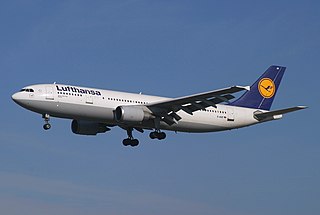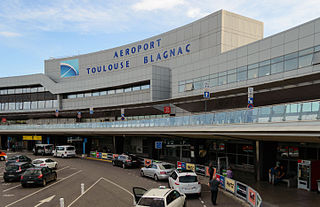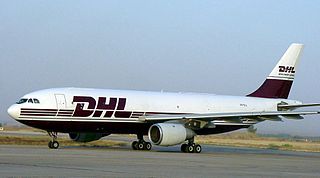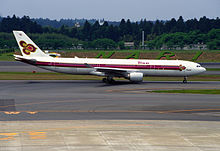
The Airbus A300 is a wide-body airliner developed and manufactured by Airbus. In September 1967, aircraft manufacturers in the United Kingdom, France, and West Germany signed a memorandum of understanding to develop a large airliner. West Germany and France reached an agreement on 29 May 1969 after the British withdrew from the project on 10 April 1969. European collaborative aerospace manufacturer Airbus Industrie was formally created on 18 December 1970 to develop and produce it. The prototype first flew on 28 October 1972.

The Airbus A310 is a wide-body aircraft, designed and manufactured by Airbus Industrie, then a consortium of European aerospace manufacturers. Airbus had identified a demand for an aircraft smaller than the A300, the first twin-jet wide-body. On 7 July 1978, the A310 was launched with orders from Swissair and Lufthansa. On 3 April 1982, the first prototype conducted its maiden flight, and the A310 received its type certificate on 11 March 1983.

The Airbus A330 is a wide-body aircraft developed and produced by Airbus. Airbus conceived several derivatives of the A300, its first airliner from the mid-1970s. Then the company began development on the A330 twinjet in parallel with the A340 quadjet and launched both designs with their first orders in June 1987. The A330-300, the first variant, took its maiden flight in November 1992 and entered service with Air Inter in January 1994. The slightly shorter A330-200 variant followed in 1998.
This is a list of aviation-related events from 1994.

Air Transat Flight 236 was a transatlantic flight bound for Lisbon, Portugal, from Toronto, Canada, that lost all engine power while flying over the Atlantic Ocean on August 24, 2001. The Airbus A330 ran out of fuel because of a fuel leak caused by improper maintenance. Captain Robert Piché, 48, an experienced glider pilot, and First Officer Dirk DeJager, 28, glided the plane to a successful emergency landing in the Azores, saving all 306 people on board. Most of the passengers on the flight were Canadians visiting Europe or Portuguese expatriates returning to visit family in Portugal. This was also the longest passenger aircraft glide without engines, gliding for nearly 75 miles or 121 kilometres. Following this unusual aviation accident, this aircraft was nicknamed the "Azores Glider".

Pilot error generally refers to an accident in which an action or decision made by the pilot was the cause or a contributing factor that led to the accident, but also includes the pilot's failure to make a correct decision or take proper action. Errors are intentional actions that fail to achieve their intended outcomes. The Chicago Convention defines the term "accident" as "an occurrence associated with the operation of an aircraft [...] in which [...] a person is fatally or seriously injured [...] except when the injuries are [...] inflicted by other persons." Hence the definition of "pilot error" does not include deliberate crashing.

Toulouse–Blagnac Airport is an international airport located 3.6 nautical miles west northwest of Toulouse, partially in Blagnac, both communes of the Haute-Garonne department in the Occitanie region of France. In 2017, the airport served 9,264,611 passengers. As of April 2017, the airport features flights to 74 destinations, mostly in Europe and Northern Africa with a few additional seasonal long-haul connections.

China Airlines Flight 140 was a regularly scheduled passenger flight from Chiang Kai-shek International Airport to Nagoya Airport in Nagoya, Japan.

TAROM Flight 371 was a scheduled international passenger flight, with an Airbus A310 from Otopeni International Airport in Romania's capital Bucharest to Brussels Airport in Brussels, Belgium. The flight was operated by TAROM, the flag carrier of Romania. On 31 March 1995, the Airbus A310-324, registered as YR-LCC, entered a nose-down dive after takeoff and crashed near Balotești in Romania. All 60 people aboard were killed in the crash.
A takeoff/go-around switch is a switch on the autothrottle of modern large aircraft, with two modes: takeoff (TO) and go-around (GA). The mode is dependent on the phase of flight; usually, on approach to land, the autopilot will be set to approach mode, therefore if the TO/GA switch is pressed it will activate the go-around mode of the autothrottle (about 90–92% N1, if pressed again, go around thrust will increase to full ; conversely, when takeoff is set on the autopilot, the switch activates takeoff mode of the autothrottle. On Boeing aircraft TO/GA modes are selected by a separate button near the throttle levers, but on Airbus aircraft it is activated by advancing the thrust levers forward to the TO/GA detent.

Armavia Flight 967 was a scheduled international passenger flight operated by Armavia from Zvartnots International Airport, Zvarnots in Armenia to Sochi, a Black Sea coastal resort city in Russia. On 3 May 2006, the aircraft operating the route, an Airbus A320-200, crashed into the sea while attempting a go-around following its first approach to Sochi airport; all 113 aboard were killed. The accident was the first major commercial airline crash in 2006. It was Armavia's first and only fatal crash.

On 22 November 2003, shortly after takeoff from Baghdad, Iraq, an Airbus A300B2-200F cargo plane, registered OO-DLL and owned by European Air Transport, was struck on the left wing by a surface-to-air missile while on a scheduled flight to Muharraq, Bahrain. Severe wing damage resulted in a fire and complete loss of hydraulic flight control systems. Because outboard left wing fuel tank 1A was full at takeoff, no fuel-air vapour explosion occurred. Liquid jet fuel dropped away as 1A disintegrated. Inboard fuel tank 1 was pierced and leaking.

Thai Airways International Flight 311 (TG311/THA311) was a flight from Bangkok, Thailand's Don Mueang International Airport to Kathmandu, Nepal's Tribhuvan International Airport. On Friday, 31 July 1992, an Airbus A310-304 on the route, registration HS-TID, crashed on approach to Kathmandu. At 07:00:26 UTC, the aircraft crashed into the side of a mountain 37 kilometres (23 mi) north of Kathmandu at an altitude of 11,500 ft (3,505 m) and a ground speed of 300 knots, killing all 113 passengers and crew members on board. This was both the first hull loss and the first fatal accident involving the Airbus A310.

Indian Airlines Flight 605 was a scheduled domestic passenger flight from Bombay to Bangalore. On 14 February 1990, an Airbus A320-231 registered as VT-EPN, crashed onto a golf course while attempting to land at Bangalore, killing 92 of 146 people on board.

British Airways Flight 38 was a scheduled international passenger flight from Beijing Capital International Airport in Beijing, China, to London Heathrow Airport in London, United Kingdom, an 8,100-kilometre trip. On 17 January 2008, the Boeing 777-200ER aircraft operating the flight crashed just short of the runway while landing at Heathrow. No fatalities occurred; of the 152 people on board, 47 sustained injuries, one serious. It was the first time in the aircraft type's history that a Boeing 777 was declared a hull loss, and subsequently written off.
Air France has been in operation since 1933. Its aircraft have been involved in a number of major accidents and incidents. The deadliest accident of the airline occurred on June 1, 2009, when Air France Flight 447, an Airbus A330-203, flying from Rio de Janeiro to Paris crashed into the Atlantic Ocean with 228 fatalities. A selected list of the most noteworthy of these events is given below.

Afriqiyah Airways Flight 771 was a scheduled international Afriqiyah Airways passenger flight that crashed on 12 May 2010 at about 06:01 local time on approach to Tripoli International Airport, about 1,200 metres short of the runway. Of the 104 passengers and crew on board, 103 were killed. The sole survivor was a 9-year-old Dutch boy. The crash of Flight 771 was the third hull-loss of an Airbus A330 involving fatalities, occurring eleven months after the crash of Air France Flight 447.

Korean Air Flight 631 (KE631/KAL631) was a scheduled passenger flight from Incheon International Airport near Seoul, South Korea to Mactan–Cebu International Airport in Metro Cebu, Philippines. On October 23, 2022, the Airbus A330-300 operating this flight overran the runway while landing in Cebu due to hydraulic failure. Despite what reports described as a "terrifying close call," all passengers and crew members survived without injuries. However, the aircraft was damaged beyond repair and written off as a result of the accident, making it the 14th hull loss of an Airbus A330.















